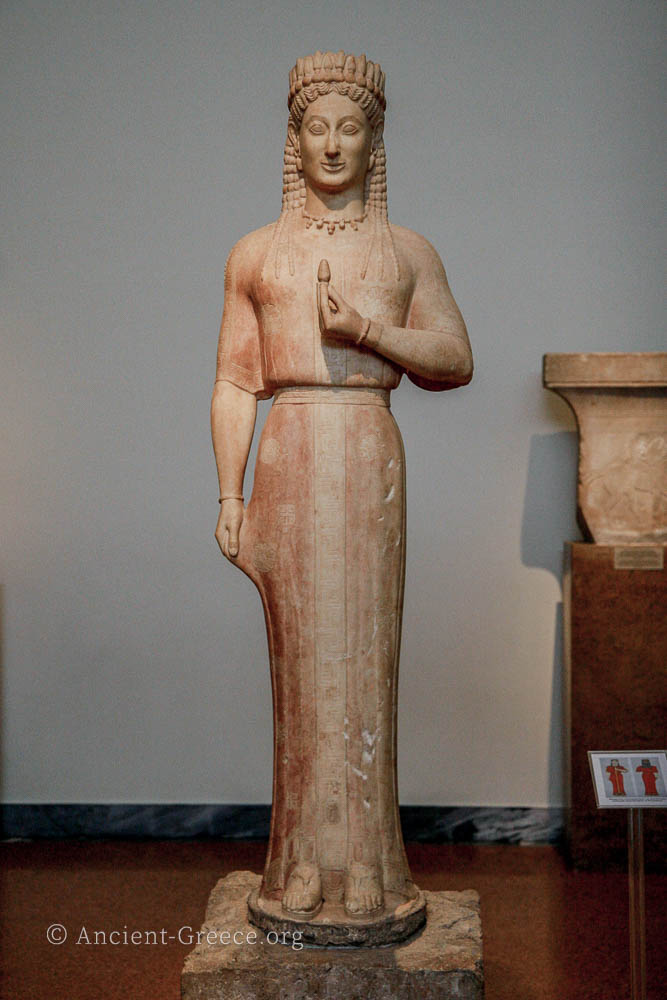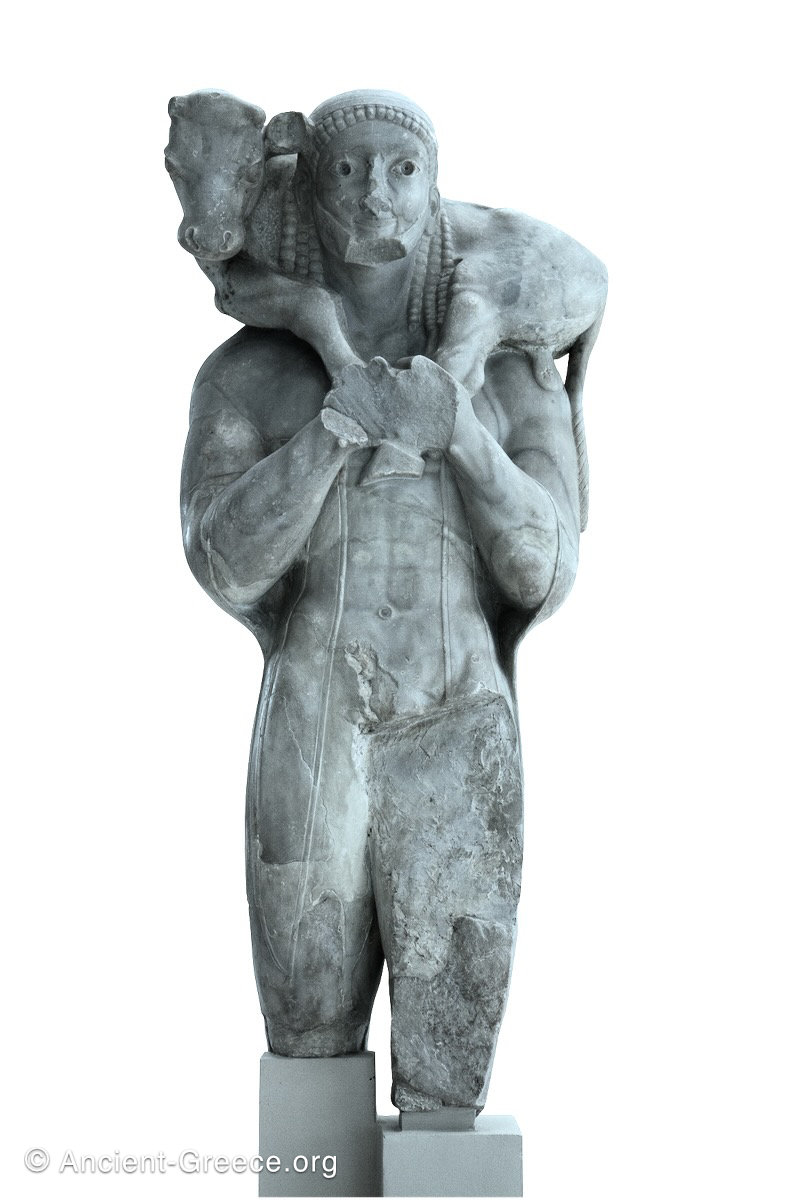
On this page:
Κούρος (Kouros: youth. Plural: Κούροι, Kouroi) sculptures were abundantly produced in Ancient Greece during the Archaic era (700-480 BCE), continuing a centuries-old tradition of votive figure statues made of bronze which was previously of small scale.
Around 600 BCE the first monumental figure sculptures appear in Greece and they depict youths, almost always standing in the nude. They were either votive or commemorative in nature.
Kouros Characteristics and Evolution
Kouros, as was the case with the Kore statues, were almost always approximately life-size (some much larger), and with few exceptions were made of marble.
The figures are depicted standing in a frontal pose with their left leg moved forward, their arms close to their bodies touching the side of their thighs, and they exhibit an almost strict symmetry as the different parts of the anatomy are depicted as simple geometric forms. In this respect, the Kouros statues have a great deal in common with earlier Egyptian monumental sculpture which undoubtedly influenced their development.
However, the similarities between Egyptian and Greek monumental statues are superficial.
The Greek Kouroi soon after the initial stages of the early 7th century begin to exhibit the marks of the inquisitive spirit, the inherit sense of freedom, and the curiosity of the Greek artists. They begin a refinement of form towards a definitive realism that was only possible through a society that revered the human form, and desired to understand the natural environment as a series of cause and effect arguments.
It is indicative of this cultural attitude that the Kouros statues depict not deities or political leaders, but mere mortal human beings who were worthy of commemoration or of eternal service to their gods.
Many of the creative processes imported from Egypt or the Middle East were adopted and retained by the Greek artists. Early monumental statues resemble Egyptian art in form and technique but were quickly refined and expanded through a series of technical and conceptual innovations. Crucially, Greek artists of the early Archaic era had the benefit of iron chisels, which were much harder than the copper and bronze ones that the Egyptians utilized.
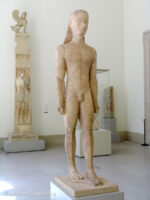
Some early Kouros utilized the Egyptian technique of dividing the figure into a rigid grid, which divided the human figure into 21 equal squares from the eyes to the feet with one-half to two more squares from the eyes to the top of the head or the headdress (New York Kouros might have been created using such grid).
Greek artists however favored a system of proportion that was relative to the individual parts of the figure. They utilized a measurement based on the length of the human foot to sketch the human body on the stone before carving, a concept that became famous later in Classical times by Polykletos. Most Kouros statues are between five and seven ancient Greek feet tall, and few are built in monumental scale.
The Greek sculptor, by not utilizing a rigid system of measurement, began depicting the parts of the human anatomy in proportions related to one another. The height of the head soon became the obvious point of reference, and a standing figure’s height was expressed by a number of “heads”. In reality, the human head’s height would fit about seven times into the man’s height, and conversely several Kouros exhibit the 1:7 head:body proportions (Kroisos, Aristodikos, Piraeus Bronze Kouros), some 1:8, some 1:6.5 (Sounio Kouros, Kleobis + Biton).





While Egyptian statues often were carved against a flat slab and at least partially clothed, Greek Kouros were freestanding and always nude, a feature that helped detach the Kouros from a specific historical setting. It is this nudity that allowed the individuals depicted in the sculpture to be seen in a context that transcends time and elevates each figure to a universal understanding.
The use of steel chisels after 500 BCE allowed for a different process of roughing-out and cutting the stone where the chisel can be held at an acute angle to cut against the stone allowing in turn for more freedom of movement and expression to the artist’s hand. In contrast, a soft chisel (like bronze) against hard stone must be held perpendicular relative to the surface, and must be used to pulverize the surface crystals slowly.
The Kouros “Smile”
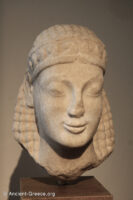
The characteristic “smile” of the Kouros and Kore bestowed an aura of joyous existence into the lifeless stone.
While this smile might have been the result of the technical difficulty of describing the transition between cheeks and lips, it became a defining feature of the Kouros and Kore statues for about a century.
The Kouros “smile” developed into a sign of progress as it slowly turned into the more austere expression of the mature statues of the late Archaic and early classical period, which relied on accuracy of form and movement to emanate their vivacity.
Toward a More Accurate Realism
The main preoccupation of the Archaic sculptor seems to be the accurate depiction of the human features, an obsession that developed for over one century until it reached its apogee in classical Greece, and its conclusion in the Hellenistic and Roman art.
The human body of the early Kouroi was depicted as a series of carefully interrelated geometric planes that broadly suggested the human features in a strict symmetrical arrangement (Metropolitan, New York Kouros).
Even in the early Arhchaic period however the preoccupation with reality is evident through the highly stylized surfaces.
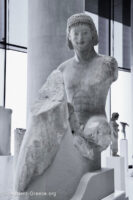
The subtle transition towards greater realism is evident in the Kroisos commemorative Kouros where the generalized anatomical features become more specific and accurate, while the strict symmetry exhibited by early statues is interrupted by subtle twists of the torso and the head (Rampin Horseman).
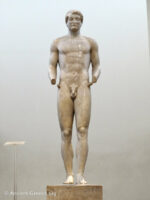
This movement towards anatomical precision and realism reaches its conclusion in the form of the “Aristodikos” Kouros, where the Greek artist achieves the long coveted accuracy of form. In Aristodikos, the Greek artist exhibits superb knowledge and understanding of the subtleties of human anatomy. Every muscle, bone, and feature is treated realistically in a manner that describes the human figure instead of suggesting it.
With this development the Greek artist was ready to take the next step towards understanding the human body as a system of parts that act and react to each other’s movements (Kritios Boy, early Classical). This consequently became one of the main preoccupations of the sculptors of the classical era.
Kouros Statues Photos





























Incomplete Kouros Statues (Abandoned in Progress)








